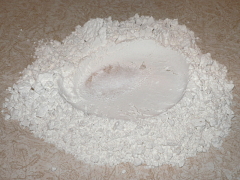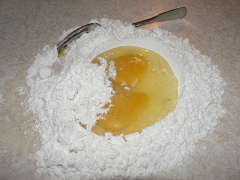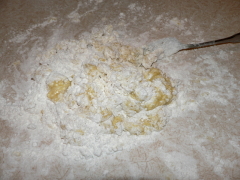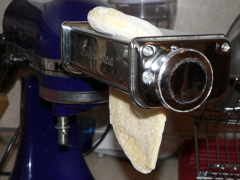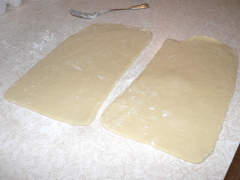(If you think you’ve seen this before, you’re right. It’s been updated with a couple more photos.)
Making fresh pasta is like renovating the kitchen before selling your house: it always pays off. And like renovating the kitchen, it takes a little work to get to the payoff. The upside is that once you’ve learned the technique it’s so easy to do you’ll keep finding excuses to make it again.
The simplest version is a basic egg pasta. This is what you’ll get in Italian restaurants … and the kitchens of Italian grandmothers. It’s just one large egg and one-half cup of flour. Mix it and roll it out and you’re done. That’s all there is to it.
Okay, that part was an exaggeration. There’s a bit more to it than that.
Start with a spotlessly-clean non-porous surface: stainless steel, marble, Formica, etc. (I’ve seen this done on wooden tables, but the cleanup is a nightmare.) Make a small volcano with a half-cup of flour.
Add the egg and one teaspoon of kosher salt to the well in the center. (I’m doing two eggs and a whole cup of flour in the pictures.)
Beat the egg(s) with a fork, and start pulling flour into the eggs a little bit at a time. Once there is enough flour mixed in that you can’t beat the egg any more, pull the rest of the flour in and start “cutting” it in with the edge of the fork.
Make sure there is a good layer of flour over the top and start kneading it with your hands.
Knead the pasta until it is all the same consistency. It should be smooth and elastic, and not sticky. If it is sticking to either your hands or the work surface, add a little more flour. This is the step that takes practice. No matter how many times you watch someone else do it you’re going to have to learn for yourself what it should feel like.
At this point, you can turn your pasta into any shape you want. I’ll assume you’re going to do some kind of flat noodle: lasagna, linguine, ravioli, etc. Some pretentious food snobs might say you have to roll it by hand. They’re idiots. Restaurants that make their own pasta all use motorized pasta rollers. And every Italian grandmother I know has a hand-cranked model somewhere in the house.
Some models are just a little different in how the pasta runs through them. Check the directions when you get one. The basic idea is that there are two adjustable metal rollers that you pass the pasta through.
You run the pasta through on the widest setting, then each pass through you go one step thinner. If the ribbon coming out gets too long to handle, just cut it in half with a pizza roller or sharp knife.
And that is all there is to it.
You can really go crazy getting other attachments for cutting special shapes. My favorite is the linguine. I leave the pasta a bit thicker than you normally would for linguine, then put the noodles in my chicken or turkey soup. The flavor is amazing. The texture of the thicker noodles is fabulous. And because they’re not dehydrated, the noodles are cooked about three or four minutes after you add them to the soup.
I recently read about someone else’s first experience making pasta. It reminded me how many times I had to do this before I really knew what I was doing. Here’s some tips:
- Start with just one egg, not two like I did above. It may not look like much, but that’s all you’re going to need to feed two people and possibly have leftovers.
- The flour-to-egg ratio is not an exact science. You want to keep adding flour until the pasta is no longer sticky. Getting this right is just going to take practice. (But hey, it’s one freaking egg, you can afford to practice.)
- After running the pasta through on the widest setting, fold it in half and run it back through again. You want to do this at least three or four times, until it’s coming out in a smooth sheet. Toontz is right that overworking it can make it tough, but underworking it will make it clumpy and uneven. Again, you’ll just need to practice.
- Get all the sheets rolled out, get the water boiling, and put the pasta into the water as soon as you cut the noodles. Don’t hang it to dry first. Unless you’re storing it, there’s no reason to dry it first. You’ll want to work sort of fast, so it’s all cooked at about the same time.
- With fresh pasta it’s a little better to under-cook than to over-cook. Unless you like mushy pasta, then go ahead and cook it as long as you like.
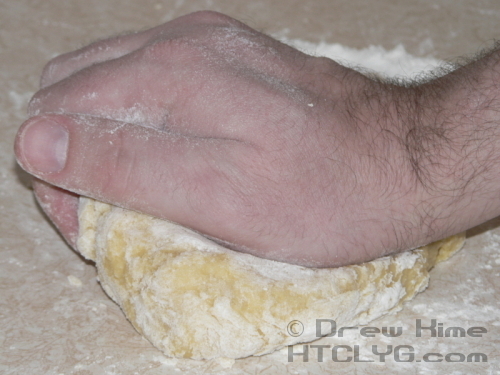
Ingredients
- 1 cup all-purpose flour
- two eggs
- 1 teaspoon kosher salt
Instructions
Make a pile on a clean counter with the flour. Make a well in the center and add the salt and eggs. Using a fork, start mixing flour into the eggs a little at a time.
When all the flour is incorporated, start kneading the dough by hand until it is smooth and elastic, and not at all sticky. Add flour a tablespoon at a time, if needed, until the dough is no longer sticky.
Roll the dough out with a pasta roller, starting on the widest setting. On each pass, turn the roller one notch thinner until the pasta is as thin as you want.
